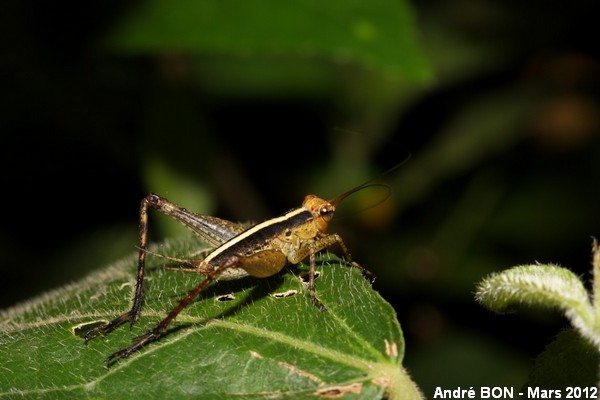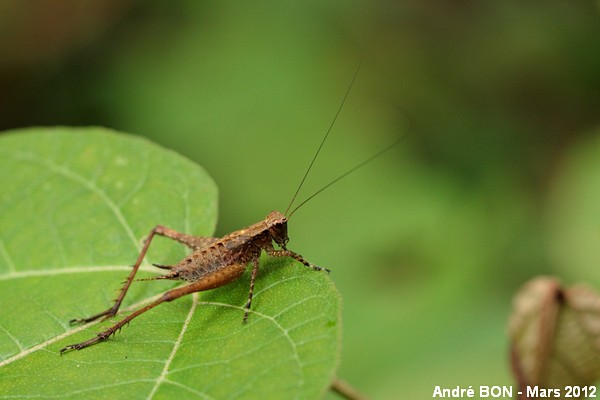

| Eneoptera sp. (Burmeister, 1838) |


|
|
Scientific name: Eneoptera sp. (Burmeister, 1838) Common name: French name: Order: Orthoptera Family: Gryllidae Wingspan : 19-20 mm without the appendages. Biotope: Open areas in tropical rain forest, in the litter or on low growing plants. Geographic area: Central America, South America. Observation period : |
The crickets of the Eneopterinae sub-family are strong insects which are generally brown or grey. The head is almost spherical, not prognathous. The mouth parts are oriented downwards. There are no setae on the upper side of the head. The eyes are protruding. The second half of the hind leg tibias bears two rows of dorsal spines with small spines in between. The fore leg and middle leg tibias do not show well marked bands. The claws at the tip of the tarsi are not bifurcate. The second segment of the hind leg tarsi, that's to say the middle segment, shows a kind of fleshy adhesive pad on the underside. The Eneoptera genus is characterized by the head morphology with a wide and keeled upper frons and by the veins on the fore wings. When restricting the area to French Guyana, and except if I am wrong, I have only noticed two listed species, Eneoptera guyanensis and Eneoptera surinamensis. You need an exam of the genitalia to tell both species apart. Eneoptera guyanensis is usually dark brown with a yellow stripe on the upper side of the hind tibia. Eneoptera surinamensis is a more contrasted colour with dark brown lateral sides and a paler brown upper side. The hind femur is a uniform brown colour. Juvenile crickets of both species have a yellowish stripe on the upper side. The Eneoptera guyanensis' song is very typical. This is a continuous song alternating sharp phases and deeper phases with a very fast transition. |
| [To know more about the Eneoptera sp.] [Next picture] [Top] |

|
I have shot this picture at Saül while walking upwards on the Belvédère footpath. You can clearly see the spines on the hind tibias, the not bifurcate tarsal claws and the pad beneath the second segment of the hind legs tarsi on the non-reduced picture. This one is probably one juvenile Eneoptera guyanensis, but I do not know exactly which criteria to use to discard Eneoptera surinamensis. So, in the doubt, I have only listed this one as Eneoptera sp. |
| [To know more about the Eneoptera sp.] [Previous picture] [Top] |

|
I have shot this picture at Saül while walking along the Monts-la-Fumée footpath. There is no pale stripe on the back. I am not quite sure of the genus identification of this Gryllidae. |